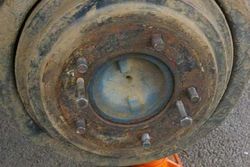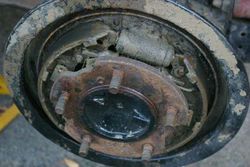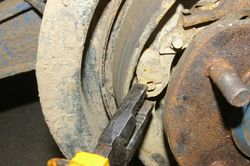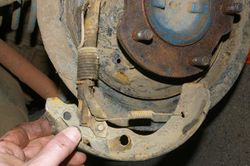Difference between revisions of "Rear brake shoes replacement"
| Line 79: | Line 79: | ||
Take the adjuster mechanism apart. Thoroughly clean the threads and ensure that the threads run really smoothly. I normally use a drop of light oil to keep the threads free of rust along with some small dabs of copper grease on any moving parts. It is worth spending some time making sure the adjuster is clean otherwise it will not work. | Take the adjuster mechanism apart. Thoroughly clean the threads and ensure that the threads run really smoothly. I normally use a drop of light oil to keep the threads free of rust along with some small dabs of copper grease on any moving parts. It is worth spending some time making sure the adjuster is clean otherwise it will not work. | ||
<br clear=all> | <br clear=all> | ||
| − | |||
| − | |||
| − | |||
| − | |||
| − | |||
| − | |||
| − | |||
| − | |||
| − | |||
| − | |||
| − | |||
| − | |||
| − | |||
| − | |||
| − | |||
| − | |||
| − | |||
| − | |||
| − | |||
| − | |||
| − | |||
| − | |||
| − | |||
| − | |||
=== Re-assembly === | === Re-assembly === | ||
This section needs completing but essentially it is a reverse procedure of above. | This section needs completing but essentially it is a reverse procedure of above. | ||
Revision as of 07:54, 5 August 2016
Contents
Rear Brake Shoes
Introduction
This is a job that I have become familiar with as mine eats brake shoes when off-roading. I have recently got as few as 250 miles out of a set and when I had the SJ I managed 29 miles between changes! This is a straight-forward job but a number of people have asked for a guide, so here it is.
So what are the symptoms of worn brake shoes:
- handbrake doesn't work
- Grating/Grinding as you brake
- Poor braking
- Lots of travel in the brake pedal
Changing the Shoes
Tools
Brake shoes
You will need suitable shoes for your car. The BigJimny store sells suitable shoes.
If your drums are particularly old and rusty you may want to consider replacing the brake mounting hardware, see suitable shoes
Although not discussed in this article (why not add it yourself, you can edit this article) the process here covers most of the actions needed to replace the rear brake cylinders if they are damaged or leaking. Again these are available in the store, Rear Brake Cylinder.
Changing the shoes
First of all secure the car, release the wheel nuts and jack up the car and remove the road wheel. This then reveals the brake drum, this has a spacer fitted to it. With all the wheel bolts removed AND THE HANDBRAKE OFF the drum can be pulled forward and off the hub.
If the drum is stuck then first of all check that the handbrake is off then insert two small bolts (M8) in the holes in the face of the drum. Reach around the back and feel near the top for a rubber bung. Remove the rubber bung and insert a flat bladed screwdriver. Angle the screwdriver so that the blade is pointing to the back of the car and the handle towards the front, you should be able to feel the adjuster wheel. Using the screwdriver turn the adjuster downwards a few clicks. Then gradually tighten the bolts you inserted in the front, the drum should come off. Do this gradually, tapping the drum as you do it. You should hear the springs/shoes relax and release as you do it. If you do it too quickly you will damage the springs.
With the drum removed the brake shoes can be seen (covered in mud in this case!). Take a really good look at how it comes apart and the position of all the springs and the handbrake adjuster arm as you will need to put it back together correctly later.
Use a small pair of pliers and remove the small spring that connects across the base of the brake shoes.
Use a pair of molegrips to remove the strong spring that joins the top of the shoes with the adjuster. Make a careful note of how the adjuster is fitted, the rod has a forked end and on part of the fork has a step in it. Make careful note of how this fork is fitted.
Now remove the shoes complete with all the springs and adjusters. The shoes are held in by a single spring clip on each side. The clip has a pin through it with a flat end on it. Grip the flat end with a pair of pliers and turn it through 90 degrees. The spring clip and pin should then be released and removed.
Now the shoes will lift away. Take care not to loose the little adjuster arm and its small spring.
Release the end of the handbrake cable from the arm on the shoe.
With it all stripped down everything should be cleaned down. Make sure that the inside of the drum is cleaned out, if necessary wire brush or emery cloth the surface to clean it up. If a lip has formed around the edge of the drum then file/grind this down as it makes the drum removal difficult.
Take the adjuster mechanism apart. Thoroughly clean the threads and ensure that the threads run really smoothly. I normally use a drop of light oil to keep the threads free of rust along with some small dabs of copper grease on any moving parts. It is worth spending some time making sure the adjuster is clean otherwise it will not work.
Re-assembly
This section needs completing but essentially it is a reverse procedure of above.











